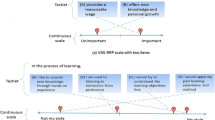Abstract
The concept of location depth was introduced as a way to extend the univariate notion of ranking to a bivariate configuration of data points. It has been used successfully for robust estimation, hypothesis testing, and graphical display. The depth contours form a collection of nested polygons, and the center of the deepest contour is called the Tukey median. The only available implemented algorithms for the depth contours and the Tukey median are slow, which limits their usefulness. In this paper we describe an optimal algorithm which computes all bivariate depth contours in O(n 2) time and space, using topological sweep of the dual arrangement of lines. Once these contours are known, the location depth of any point can be computed in O(log2 n) time with no additional preprocessing or in O(log n) time after O(n 2) preprocessing. We provide fast implementations of these algorithms to allow their use in everyday statistical practice.
Similar content being viewed by others
References
Anagnostou E.G., Guibas L.J., and Polimenis V.G. 1990. Topological sweeping in three dimensions. In: Proceedings of 1st Annual SIGAL International Symposium on Algorithms, Springer-Verlag, Lecture Notes in Computer Science, vol. 450, pp. 310–317.
Bai Z.-D. and He X. 1999. Asymptotic distributions of the maximal depth estimators for regression and multivariate location. The Annals of Statistics 27: 1616–1637.
de Berg M., van Kreveld M., Overmars M., and Schwarzkopf O. 1997. Computational Geometry: Algorithms and Applications. Springer-Verlag, Berlin.
Cleveland W.S. 1993. Visualizing Data. Hobart Press, Summit, New Jersey.
Cole R., Sharir M., and Yap C.K. 1987. On k-hulls and related problems. SIAM Journal on Computing 15: 61–77.
Dey T. 1998. Improved bounds on planar k-sets and related problems. Discrete and Computational Geometry 19: 373–382.
Dobkin D.P. and Souvaine D.L. 1987. Computational Geometry-A User's Guide. Chapter 2 in: Schwartz J.T and Yap C.K. (Eds.), Advances in Robotics 1: Algorithmic and Geometric Aspects of Robotics, Lawrence Erlbaum Associates, pp. 43–93.
Donoho D.L. and Gasko M. 1992. Breakdown properties of location estimates based on halfspace depth and projected outlyingness. The Annals of Statistics 20: 1803–1827.
Edelsbrunner H. 1987. Algorithms in Combinatorial Geometry, Springer-Verlag, Berlin.
Edelsbrunner H. and Guibas L.G. 1989. Topologically sweeping an arrangement. Journal of Computer and System Sciences 38: 165–194.
Edelsbrunner H., Guibas L.J., and Stolfi J. 1986. Optimal point location in a monotone subdivision. SIAM Journal of Computing 15(2): 317–340.
Edelsbrunner H. and Souvaine D. 1990. Computing median-of-squares regression lines and guided topological sweep. Journal of the American Statistical Association 85: 115–119.
Hodges J.L. 1955. A bivariate sign test. The Annals of Mathematical Statistics 26: 523–527.
Kirkpatrick D. 1983. Optimal search in planar subdivisions. SIAM Journal on Computing 12: 28–35.
Langerman S. and Steiger W. 2000. Computing a Maximal Depth Point in the Plane. Proceedings 4th Japan Conference on Discrete and Computational Geometry, Lecture Notes in Computer Science, to appear.
Liu R.Y. 1990. On a notion of data depth based on random simplices. The Annals of Statistics 18: 405–414.
Liu R.Y., Parelius J., and Singh K. 1999. Multivariate analysis by data depth: Descriptive statistics, graphics and inference. The Annals of Statistics 27: 783–840.
Liu R.Y. and Singh K. 1997. Notions of limiting P values based on data depth and bootstrap. Journal of the American Statistical Association 92: 266–277.
Matoušek J. 1991. Computing the center of planar point sets. DIMACS Series in Discrete Mathematics and Theoretical Computer Science 6: 221–230.
Mitchell T. 2002. Point location in a nested set of convex hulls. Senior Design Project, EECS Department, Tufts University. <http://www.eecs.tufts.edu/r/geometry/depthquery>
Preparata F. and Shamos M.I. 1985. Computational Geometry: An Introduction. Springer-Verlag, New York.
Rafalin E., Souvaine D., and Streinu I. 2002. Topological Sweep in Degenerate cases. Algorithms Engineering and Experiments (ALENEX 2002). Springer-Verlag Lecture Notes in Computer Science 2409: 155–165.
Rosenberger H. 1990. Topological plane sweep implemented in C, University of Illinois at Urbana-Champaign.
Rousseeuw P.J. 1984. Least median of squares regression. Journal of the American Statistical Association 79: 871–880.
Rousseeuw P.J. and Ruts I. 1996. Algorithm AS 307: Bivariate location depth. Applied Statistics (JRSS-C) 45: 516–526.
Rousseeuw P.J. and Ruts I. 1998. Constructing the bivariate Tukey median. Statistica Sinica 8: 827–839.
Rousseeuw P.J., Ruts I., and Tukey J.W. 1999. The bagplot: A bivariate boxplot. The American Statistician 53: 382–387.
Rousseeuw P.J. and Struyf A. 1998. Computing location depth and regression depth in higher dimensions. Statistics and Computing 8: 193–203.
Rousseeuw P.J. and Struyf A. 2002. Characterizing angular symmetry and regression symmetry. Journal of Statistical Planning and Inference, to appear.
Ruts I. and Rousseeuw P.J. 1996. Computing depth contours of bivariate point clouds. Computational Statistics and Data Analysis 23: 153–168.
Sarnak N. and Tarjan R.E. 1986. Planar point location using persistent search trees. Communications of the ACM 29: 669–679.
Souvaine D. and Steele J.M. 1987. Efficient time and space algorithms for least median of squares regression. Journal of the American Statistical Association 82: 794–801.
Tukey J.W. 1975. Mathematics and the picturing of data. Proceedings of the International Congress of Mathematicians, Vancouver 2: 523–531.
Tukey J.W. 1977. Exploratory Data Analysis. Addison-Wesley, Reading, MA.
Wenger R. 1997. Helly-Type theorems and geometric transversals. In: Goodman J.E. and O'Rourke J. (Eds.), Handbook of Discrete and Computational Geometry, CRC Press, pp. 63–82.
Author information
Authors and Affiliations
Rights and permissions
About this article
Cite this article
Miller, K., Ramaswami, S., Rousseeuw, P. et al. Efficient computation of location depth contours by methods of computational geometry. Statistics and Computing 13, 153–162 (2003). https://doi.org/10.1023/A:1023208625954
Issue Date:
DOI: https://doi.org/10.1023/A:1023208625954




